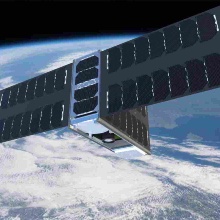The continuously growing need for higher data rates as well as globally available broadband internet requires innovative technology developments and the exploitation of a new electromagnetic spectrum. In the scope of R&D projects funded by the German Aerospace Center, researchers at the University of Stuttgart have developed a high-performance technology platform to exploit the frequency spectrum in the so-called E-band at 71-86 GHz. State-of-the-art transmissions in terrestrial radio-relay and an initial gigabit data transmission between an aircraft and a ground station justify and motivate a first verification of this technology in the space environment.
At this point, the research project EIVE starts with a worldwide first in-orbit verification of a communication link in the E-Band. A central part of the scientific objectives of this project is to accomplish a broadband data downlink in the previously unused frequency range of 71-76 GHz from a nanosatellite to a ground station.Detailed link budget calculations show the feasibility of a data downlink during an overflight in the sun-synchronous low earth orbit with a full bandwidth of 5 GHz by incorporating realistic antenna dimensions and availabilities.The partners of the EIVE project group are highly qualified for the implementation of this project due to their competence profiles and prior art.
The EIVE project network is coordinated by the Institute of Robust Power Semiconductor Systems (ILH) at the University of Stuttgart and is composed of the Institute of Space Systems (IRS) of the University of Stuttgart, the Fraunhofer Institute for Applied Solid State Physics (IAF), the Radiometer Physics GmbH as well as the Tesat-Spacecom GmbH. In addition, the German Center for Satellite Communications e.V. based in Backnang will support the project in the area of public relations.
With the planned data downlink from a nano-satellite platform to the ground station at the University of Stuttgart, the feasibility of broadband data links in an up to now unused frequency range for satellite communication shall be demonstrated within an in-orbit verification. In addition, the EIVE satellite will address payload applications and earth observation services that are expected to be adopted by the increasingly popular nano-satellites in low earth orbit.
Global satellite networks that can be integrated seamlessly into terrestrial fiber and wireless networks based on innovative technologies, can provide worldwide available broadband internet and ensure data-intensive Internet of Things (IoT) services.
About Institute of Robust Power Semiconductor Systems (ILH) of the University of Stuttgart
Since its creation in 2013 scientists at the ILH of the University of Stuttgart are working on innovations in the area of microelectronic circuits and systems for applications in power and microwave electronics. The research focus of the presently 15 scientists and numerous students at the ILH is on the use of modern semiconductor technologies in high performance transceivers for high bit rate wireless communication, and in compact voltage converters for electro-mobility and regenerative energies.
Expert Contact:
Professor Ingmar Kallfass
University of Stuttgart, Institute of Robust Power Semiconductor Systems
Tel: 0711/685-68747


